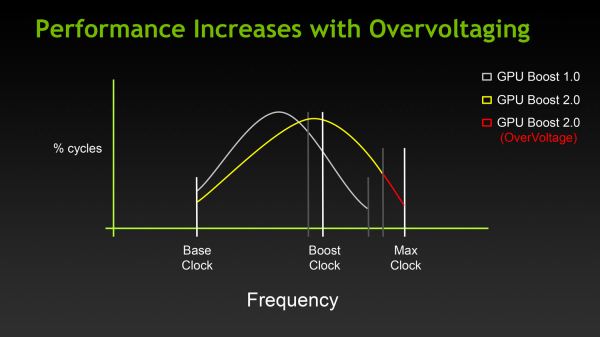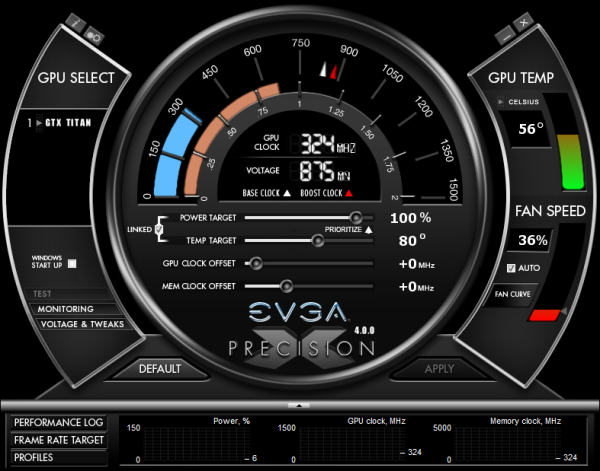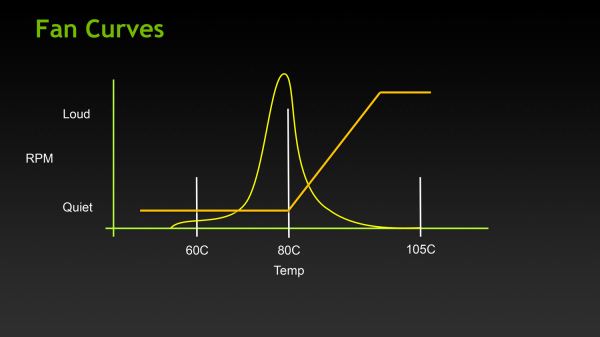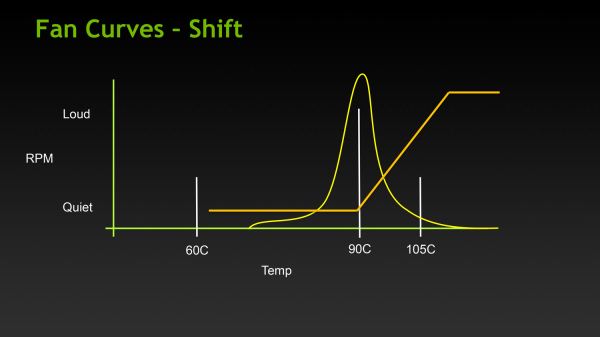NVIDIA's GeForce GTX Titan, Part 1: Titan For Gaming, Titan For Compute
by Ryan Smith on February 19, 2013 9:01 AM ESTGPU Boost 2.0: Overclocking & Overclocking Your Monitor
The first half of the GPU Boost 2 story is of course the fact that with 2.0 NVIDIA is switching from power based controls to temperature based controls. However there is also a second story here, and that is the impact to overclocking.
With the GTX 680, overclocking capabilities were limited, particularly in comparison to the GeForce 500 series. The GTX 680 could have its power target raised (guaranteed “overclocking”), and further overclocking could be achieved by using clock offsets. But perhaps most importantly, voltage control was forbidden, with NVIDIA going so far as to nix EVGA and MSI’s voltage adjustable products after a short time on the market.
There are a number of reasons for this, and hopefully one day soon we’ll be able to get into NVIDIA’s Project Greenlight video card approval process in significant detail so that we can better explain this, but the primary concern was that without strict voltage limits some of the more excessive users may blow out their cards with voltages set too high. And while the responsibility for this ultimately falls to the user, and in some cases the manufacturer of their card (depending on the warranty), it makes NVIDIA look bad regardless. The end result being that voltage control on the GTX 680 (and lower cards) was disabled for everyone, regardless of what a card was capable of.
With Titan this has finally changed, at least to some degree. In short, NVIDIA is bringing back overvoltage control, albeit in a more limited fashion.
For Titan cards, partners will have the final say in whether they wish to allow overvolting or not. If they choose to allow it, they get to set a maximum voltage (Vmax) figure in their VBIOS. The user in turn is allowed to increase their voltage beyond NVIDIA’s default reliability voltage limit (Vrel) up to Vmax. As part of the process however users have to acknowledge that increasing their voltage beyond Vrel puts their card at risk and may reduce the lifetime of the card. Only once that’s acknowledged will users be able to increase their voltages beyond Vrel.

With that in mind, beyond overvolting overclocking has also changed in some subtler ways. Memory and core offsets are still in place, but with the switch from power based monitoring to temperature based monitoring, the power target slider has been augmented with a separate temperature target slider.
The power target slider is still responsible for controlling the TDP as before, but with the ability to prioritize temperatures over power consumption it appears to be somewhat redundant (or at least unnecessary) for more significant overclocking. That leaves us with the temperature slider, which is really a control for two functions.
First and foremost of course is that the temperature slider controls what the target temperature is for Titan. By default for Titan this is 80C, and it may be turned all the way up to 95C. The higher the temperature setting the more frequently Titan can reach its highest boost bins, in essence making this a weaker form of overclocking just like the power target adjustment was on GTX 680.
The second function controlled by the temperature slider is the fan curve, which for all practical purposes follows the temperature slider. With modern video cards ramping up their fan speeds rather quickly once cards get into the 80C range, merely increasing the power target alone wouldn’t be particularly desirable in most cases due to the extra noise it generates, so NVIDIA tied in the fan curve to the temperature slider. By doing so it ensures that fan speeds stay relatively low until they start exceeding the temperature target. This seems a bit counterintuitive at first, but when put in perspective of the goal – higher temperatures without an increase in fan speed – this starts to make sense.
Finally, in what can only be described as a love letter to the boys over at 120hz.net, NVIDIA is also introducing a simplified monitor overclocking option, which can be used to increase the refresh rate sent to a monitor in order to coerce it into operating at that higher refresh rate. Notably, this isn’t anything that couldn’t be done before with some careful manipulation of the GeForce control panel’s custom resolution option, but with the monitor overclocking option exposed in PrecisionX and other utilities, monitor overclocking has been reduced to a simple slider rather than a complex mix of timings and pixel counts.
Though this feature can technically work with any monitor, it’s primarily geared towards monitors such as the various Korean LG-based 2560x1440 monitors that have hit the market in the past year, a number of which have come with electronics capable of operating far in excess of the 60Hz that is standard for those monitors. On the models that have been able to handle it, modders have been able to get some of these 2560x1440 monitors up to and above 120Hz, essentially doubling their native 60Hz refresh rate to 120Hz, greatly improving smoothness to levels similar to a native 120Hz TN panel, but without the resolution and quality drawbacks inherent to those TN products.
![]()
Of course it goes without saying that just like any other form of overclocking, monitor overclocking can be dangerous and risks breaking the monitor. On that note, out of our monitor collection we were able to get our Samsung 305T up to 75Hz, but whether that’s due to the panel or the driving electronics it didn’t seem to have any impact on performance, smoothness, or responsiveness. This is truly a “your mileage may vary” situation.














157 Comments
View All Comments
CeriseCogburn - Monday, March 4, 2013 - link
lol - DREAM ON about goodwill and maintaining it.nVidia is attacked just like Intel, only worse. They have the least amount of "goodwill" any company could possibly have, as characterized by the dunderheads all over the boards and the also whining reviewers who cannot stand the "arrogant know it all confident winners who make so much more money playig games as an nVidia rep"...
Your theory is total crap.
What completely overrides it is the simple IT JUST WORKS nVidia tech and end user experience.
Add in the multiplied and many extra features and benefits, and that equals the money in the bank that lets the end user rest easy that new games won't become an abandoned black holed screen.
Reputation ? The REAL reputation is what counts, not some smarmy internet crybaby loser with lower self esteem than a confident winner with SOLID products, the BEST of the industry.
That's arrogance, that's a winner, that's a know it all, that's Mr. Confidence, that's the ca$h and carry ladies magnet, and that's what someone for the crybaby underdog loser crash crapster company cannot stand.
Galvin - Tuesday, February 19, 2013 - link
Can this card do 10bit video or still limited to 8bit?alpha754293 - Tuesday, February 19, 2013 - link
Does this mean that Tesla-enabled applications will be able to make use of Titan?Ryan Smith - Tuesday, February 19, 2013 - link
It depends on what features you're trying to use. From a fundamental standpoint even the lowly GT 640 supports the baseline Kepler family features, including FP64.Ankarah - Tuesday, February 19, 2013 - link
Highly unusual for a company to have two of their products at the exact same price point, catering to pretty much the same target audience.I guess it could be viewed as a poor-man's-Tesla but as far as the gaming side goes, it's quite pointless next to the 690, not to mention very confusing to anyone other than those are completely up-to-date on the latest news stories.
CeriseCogburn - Monday, March 4, 2013 - link
Let's see, single GPU core fastest in the gaming world, much lower wattage, no need for profiles, constant FPS improvement - never the same or no scaling issues across all games, and you find it strange ?I find your complete lack of understanding inexcusable since you opened the piehole and removed all doubt.
Voidman - Tuesday, February 19, 2013 - link
Finally somehting I could be excited about. I have a hard time caring much about the latest smart phone or tablet. A new high end video card though is something different all together. And then it turns out to be a "luxury product" and priced at 1k. Cancel excitement. Oh well, I'm happy with my 680 still, and I'm pretty sure I've still got overclocking room on it to boot. But for all those that love to hate on either AMD or Nvidia, this is what happens when one is not pushing the other. I have no doubt what so ever that AMD would do the same if they were on top at the moment.HanakoIkezawa - Tuesday, February 19, 2013 - link
The price is a bit disappointing but not unexpected. I was hoping this would be 750-850 not so I could buy one but so that I could get a second 670 for a bit cheaper :DBut in all seriousness, this coming out does not make the 680 or 670 any slower or less impressive. In the same way the 3970x's price tag doesn't make the 3930k any less of a compelling option.
johnsmith9875 - Tuesday, February 19, 2013 - link
Why not just make the video card the computer and let the intel chip handle graphics???Breit - Tuesday, February 19, 2013 - link
Thanks Ryan, this made my day! :)Looking forward to part 2...